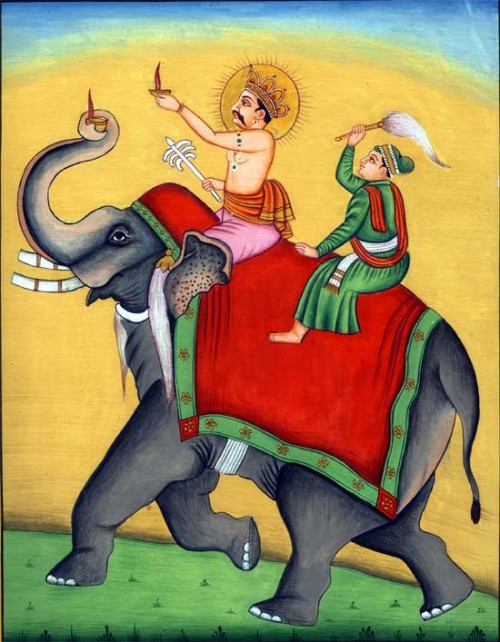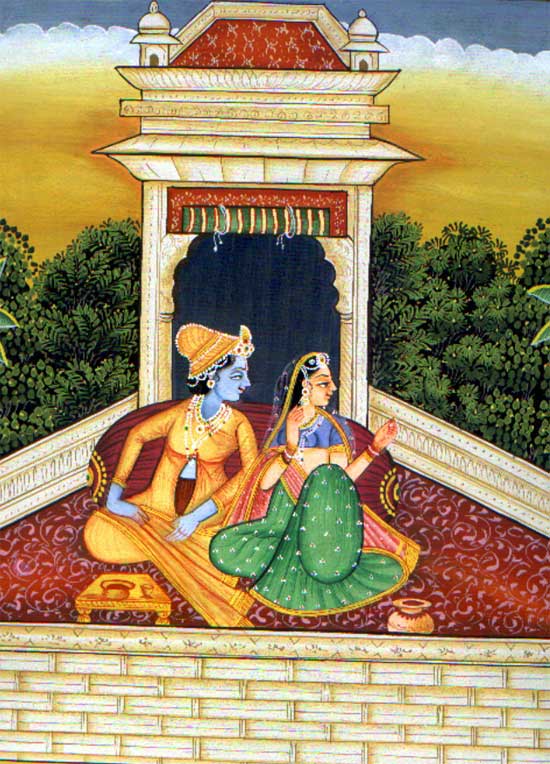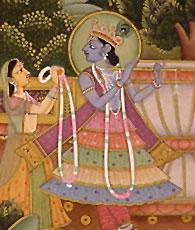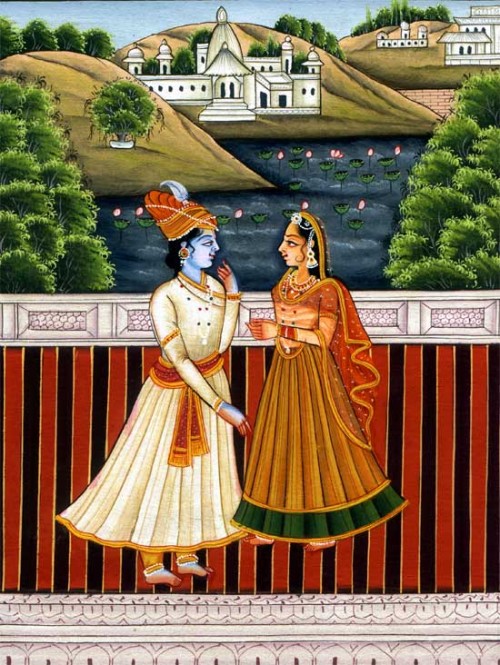ॐ श्री गुरुभ्यो नमः ॐ श्री शिवानन्दाय नमः ॐ श्री चिदानन्दाय नमः ॐ श्री दुर्गायै नमः
Source of all Images in this Blog-post : Google Images : ‘Google Image Search’ will reveal the multiple sources of every single image shared in this Blog. For more details, kindly see ‘Disclaimer‘
Kangra painting is the pictorial art of Kangra, named after Kangra, Himachal Pradesh, a former princely state, which patronized the art.
It became prevalent with the fading of Basohli school of painting in mid-18th century, and soon produced such a magnitude in paintings both in content as well as volume, that the Pahari painting school, came to be known as Kangra paintings.

Want to Buy Kangra Painting Online? : Explore Google Shopping
Though the main centres of Kangra paintings are Guler, Basohli, Chamba, Nurpur, Bilaspur and Kangra. Later on this style also reached Mandi, Suket, Kullu, Arki, Nalagarh and Tehri Garhwal (represented by Mola Ram).
These are now collectively known as Pahari painting, covering the style that was patronized by Rajput rulers between the 17th and 19th centuries.
Pahari paintings, as the name suggests, were paintings executed in the hilly regions of India, in the sub-Himalayan state of Himachal Pradesh.
It is in the development and modification of Pahari paintings, that the Kangra School features. Under the patronage of Maharaja Sansar Chand (c.1765–1823), it became the most important center of Pahari painting.

A Glance at Indian Miniature Art – Kangra Painting through Google Images
To see some of these master pieces one can visit the Maharaja Sansar Chand Museum, adjoining the Kangra Fort in Kangra Himachal, founded by the erstwhile Royal Family of Kangra.

History :
Sansar Chand (c.1765–1823), an early patron of the Kangra style
This great art originated in Guler State, a small hill state in the Lower Himalayas in the first half of the 18th century.
This is when a family of Kashmiri painters trained in Mughal painting style sought shelter at the court of Raja Dalip Singh (r. 1695–1741) of Guler.
The rise of Guler Paintings started in what is known as the Early phase of Kangra Kalam. The new arrivals mingled with the local artists and were greatly influenced by the atmosphere of the hills.
Instead of painting flattering portraits of their masters and love scenes, the artistes adopted themes of eternal love between Radha and Krishna. The paintings were naturalistic and employed cool, fresh colors.
The colors were extracted from minerals, vegetables, and possessed enamel-like luster. Verdant greenery of the landscape, brooks, springs were the recurrent images on the miniatures.

Nainsukh (1710–1778), succeeded by two generations of his family workshop, introduced a distinctive style that combined Mughal elements with personal innovations.
This style reached its zenith during the reign of Maharaja Sansar Chand Katoch (r.1776–1824) who was a great patron of Kangra art. Being a liberal patron, the painters working at his atelier received large commissions while others accepted a permanent settlement in the form of lands.

Maharaja Sansar Chand was an ardent devotee of Krishna and used to commission artists to paint subjects based on the loves and life of Krishna.
The Guler-Kangra art is the art of drawing and the drawing is precise and fluid, lyrical, and naturalistic. In these styles, the faces are well modeled and shaded so judiciously that they possess almost porcelain-like delicacy.

Themes :
The focal theme of Kangra painting is Shringar (the erotic sentiment). The subjects are seen in Kangra painting exhibit the taste and the traits of the lifestyle of the society of that period.
Bhakti cult was the driving force and the love story of Radha and Krishna was the main source of spiritual experience, which was also the base for the visual expression.

Bhagavata Purana and the love poems Gita Govinda by Jayadeva were the most popular subjects dealing with the legends and the amorous plays of Radha and Krishna symbolizing the soul’s devotion to God.
In some miniatures, the blue-god Krishna is seen dancing in the lush woodlands and every maiden’s eye is drawn to him. Krishna subjects, known commonly as Krishna-Lila predominate, while the themes of love, inspired by the Nayaks and nayikas and Baramasa enjoyed great favor.

The sentiment of love remained the inspiration and the central theme of Pahari painting. The Sat Sai depictions of the legendary lovers, on the other hand, were set against an architectural background with walls, balconies, and windows.
Kangra paintings influenced by the Bhagavatha Purana portrayed incidents from the life of the young Krishna, against the Brindavan forest or river Yamuna.
The other popular themes were the stories of Nala and Damayanti, and those from Keshavdas’s Baramasa.

Features of Kangra Painting :
One striking feature of Kangra paintings is the verdant greenery it depicts. The style is naturalistic, and great attention is paid to detail.
The foliage depicted is vast and varied. This is made noticeable by using multiple shades of green. The Kangra paintings feature flowering plants and creepers, leafless trees, rivulets, and brooks.

The Kangra artists adopted various shades of the primary colors and used delicate and fresher hues. For instance, they used a light pink on the upper hills to indicate distance.
Kangra paintings depict the feminine charm in a very graceful manner. Facial features are soft and refined. The female figures are exceptionally beautiful.A regal figure seated on a throne, Pahari school.
Later Kangra paintings also depicted nocturnal scenes, and storms, and lightning. The paintings were often large and had complex compositions of many figures and elaborate landscapes. Towns and house clusters were often depicted in the distance.
The Kangra painters used colors made of vegetable and mineral extracts. They employed cool and fresh colors. Kangra paintings are known for the lyrical blending of form and color.
The Kangra Arts Promotion Society an NGO at Dharamshala Himachal Pradesh is working for the promotion of this art which is on the verge of extinction today.
This NGO is running a school to train young boys and girls in this art. It also runs a workshop where genuine Kangra Paintings are made on traditional handmade paper using only mineral and vegetable colors.
Kangra painting is the pictorial art of Kangra, named after Kangra, Himachal Pradesh, a former princely state, which patronized the art.

The art-form became prevalent with the fading of Basohli school of painting in mid-18th century, and soon produced such a magnitude in paintings both in content as well as volume, that the Pahari painting school, came to be known as Kangra paintings.
In the middle of the 18th century A.D. when the plains of Northern India were convulsed by the invasion of Nadir Shah (1739), followed by the incursions of Ahmad Shah Abdah, a strange event took place in the Punjab hills viz. the birth of the Kangra School of Painting at Haripur-Guler under the patronage of Raja Govardhan Chand (1744-1773), a prince with a refined taste and passion for painting.
He gave asylum to refugee artists trained in the Mughal Style of painting. In the inspiring environment of the Punjab Himalayas with their beautiful green hills wave-like terraced paddy-fields and rivulets fed with the glacial waters of the snow-covered Dhauladhar , the Mughal style with its sensitive naturalism blossomed into the Kangra style.
Instead of painting flattering portraits of their masters and hunting scenes, the artists adopted themes from the love poetry of Jayadeva Bihari and Keshav Das who wrote ecstatically of the divine love of Radha and Krishna.
Thus, developed a school of painting with new spirit, whose artistic works are suffused with romantic love and Bhakti mysticism.
Parkash Chand (ruled 1773-1790), the successor of Govardhan Chand, also continued the patronage of the artists. The paintings in early Guler style were by the artist Pandit Seu and his two sons.
Raja Sansar Chand (1775-1823) attracted a number of talented artists from the court of Guler even when he was 20 years of age. He was the most renowned Raja in the Kangra Valley and was the most generous patron of the art of painting.
It was under his patronage that Jaydeva’s Sanskrit love poem, the ‘Gita Govinda’, ‘Bihari’s Sat Sai’, ‘Bhagawat Purana’, the romantic tale of Nala and Damyanti , and Keshav Das’s Raskapriya and Kavipriya were translated into paintings of exquisite beauty.
Manku, Khushala, Kishan Lal, Basia, Purkhoo, Fatoo are also mentioned as artists in the employment of Sansar Chand, and his son Ramdyal is also mentioned. These artist did not mention their names on the painting which also shows their selfless devotion to the art.
To turn to the techniques of Kangra Painting, its chief features are delicacy of line, brilliance of color and minuteness of decorative details, like the art of Ajanta.
Kangra art is essentially an art of the line. This imaging delicacy and fineness of the line was achieved by the use of fine brushes made from the hair of squirrels.
The Kangra painters made use of pure colors like yellow, red and blue and these have retained the brilliance even after two hundred years.
The central theme of Kangra painting is live and its sentiments are expressed in a lyrical style full of rhythm, grace and beauty. The recurring theme of Kangra painting whether it portrays one of the six seasons or modes of music, Radha and Krishana or Siva and Parvati is the love of man for woman and of woman for man.
The three main centers of Kangra painting are Guler, Nurpur and Tira-Sujanpur.
Painting depicts ideas and values which guided life in society, sentiments and passions pictured in the language of brush and color to make our experience rich and sensibilities sharp.
Miniatures are steeped in religious faith as they depict Puranic tales and stories from Ramayana and Mahabharata in minute detail.

Sensitive depiction of literary works RasikPriya, Sat Sai and Rasmanjari, Geet Govinda and other works refer to the awareness of people. The episodes are most eloquent, colours most vibrant, brilliant and soft. The brush is tender. Nature sublime. Animal & birds find place wherever necessary.

The Nayika of miniature is Radha, the most beautiful woman on earth characterized by feminine grace and Nayak is none other than the blue God Krishna. We also see the hill Rajas modelling as the Nayak.

Portraits of hill Rajas give us a glimpse into their character, likes and attributes. But for the liberal patronage available this art would not have touched such high levels of excellence.
The main centres of Kangra paintings are Guler, Basohli, Chamba, Nurpur, Bilaspur and Kangra. Later on this style also reached Mandi, Suket, Kulu, Arki, Nalagarh and Tehri Garhwal.
These are now collectively known as Pahari painting, covering the style that was patronized by Rajput rulers between the 17th and 19th centuries.
Pahari paintings, as the name suggests, were paintings executed in the hilly regions of India, in the sub-Himalayan state of Himachal Pradesh. It is in the development and modification of Pahari paintings, that the Kangra School features. Under the patronage of Maharaja Sansar Chand, it became the most important center of Pahari painting.
To see some of these master pieces one can visit the Maharaja Sansar Chand Museum, adjoining the Kangra Fort in Kangra Himachal. This museum has been founded by the erst-while Royal Family of Kangra.
